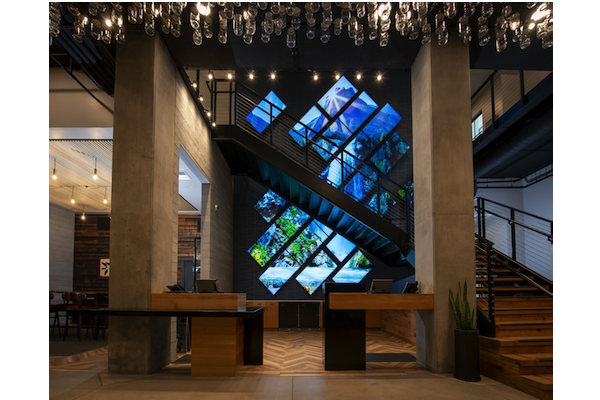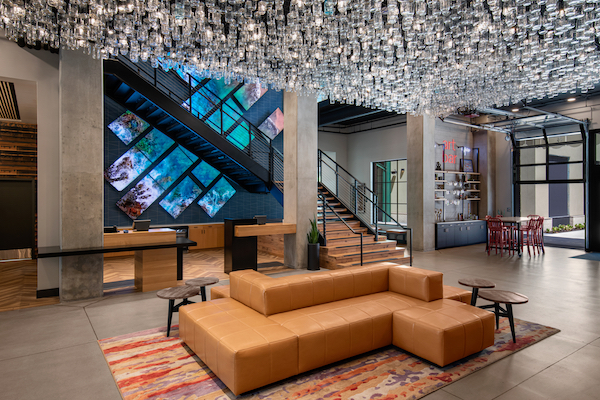Digital art can heighten visual impact, set a mood and offer the simple ability to change content frequently.
Obie Hospitality’s The Gordon Hotel opened last year in Eugene, Oregon, and it has a 21-screen digital art installation from art collective Harmonic Laboratory. Titled The Great Wall, the digital art spans two floors and is located behind reception in the lobby. The Gordon has now had a chance to work out the kinks and change out the art, even hosting showcases for the University of Oregon digital art students who have contributed content.
As hoteliers consider the pros and cons of digital art, HOTELS explores the medium from the perspective of the hotelier and artist – both from a cost perspective as well as guest (and staff) impact. We conducted a Q&A with Nicole Roselio, marketing director and brand innovator for Eugene-based Obie Hospitality, as well as John Park, Eugene-based Harmonic Laboratory’s project lead for The Great Wall project.
HOTELS: Did you always know you wanted digital art for The Gordon Hotel, and if not, how did you come to that decision?
Nicole Roselio: We were familiar with Harmonic Laboratory’s work and were impressed by their large-scale installations. Originally, we were planning for a large mural in the lobby, but we wanted something a bit more engaging that was also an opportunity to showcase different artists and rotating art. We didn’t want it to be static. So, we showed Harmonic the space and the ceiling, and they presented a few ideas. We all decided that the digital wall was the route we wanted to go.

H: Budget-wise, are you happy with your decision? Anything you would have changed or would caution other hoteliers to think about before embarking on a project like this?
NR: It’s an investment. There are hotels that will choose a couple of pieces of art that are very prominent, and that’s what they want to fold into the guest experience. I think what I love about this is that we didn’t set out to do it. When we were designing the space, we knew our goal but not how to achieve it. My recommendation is to set aside what you want to spend, but don’t define it or restrain yourself. Allow for fluidity to try something that may be unexpected but still fit your goals. This was a year-long process in exploration and figuring out the logistics. If you don’t allow time for that, you might miss it.
We did a small mockup of The Great Wall in our model room as a test, where Harmonic assembled it and figured out all the cabling and programming before they duplicated it at 3x the scale, which certainly helped. Because they did that, it allowed for us to make some adjustments before the big install happened. Harmonic also continues to help troubleshoot. If a screen goes out, they are there to fix it, which wouldn’t be possible if they weren’t local.
H: What has guest feedback been like re: the wall?
NR: From the moment that people started walking in that lobby, you would see them just stop and stare. It’s so unexpected. Even after opening several months ago, I still see people bringing in visitors or family/friends to show them, and some people just sit on the couch and watch it. Not even guests per say, but locals. It definitely met our goal of having a place to engage and have rotating art. It also creates an energy in the space based on what content is playing. We’ve learned to intentionally program the nature/more soothing content in the morning time, which also has slower transitions among images. In the evening we’ll showcase the edgier and more vibrant student work, which also has a sharper pace and sense of movement. You definitely feel the shift.

H: In your future Obie Hospitality projects, do you think you’ll be doing more digital art installations? If so, why?
NR: I would like to, yes. The magnitude of this one means it’s a very particular artist who knows how to create for it. While the wall does showcase different artists, it does narrow the scope/field of artists who can participate. Perhaps to make it more accessible to other artists, we’d have a smaller-scale piece/screens at a future property, now knowing what it takes to create those pieces.
H: What would you have done differently if you had to do it over?
John Park: We were lucky to have entered this project when we did, essentially when ground was being broken on the hotel, but before electrical and interior materials had been chosen. With hindsight, we would probably opt for larger screens and fewer of them when filling the same sized space. The technical needs of the project and the content creation of the video imagery displayed on the screens is tied to the total number of screens. So, 15 65-inch screens would have been much simpler to handle than 21 55-inch screens.
H: Any advice for hoteliers seeking out digital artists to partner with, things they should think about?
JP: We suggest hoteliers think of digital artists as partners and creative problem-solvers who have the training and skill sets to develop innovative experiences. The media landscape is saturated with billions of small screens in the form of smartphones, but the experiences of viewing large video installations or digital projections in hospitality spaces can offer a digital landmark for a place that no phone app can rival… Digital art offers a blend between the physical architecture of a hotel and a meaningful connection to the surrounding geography for which guests are hoping to experience.

